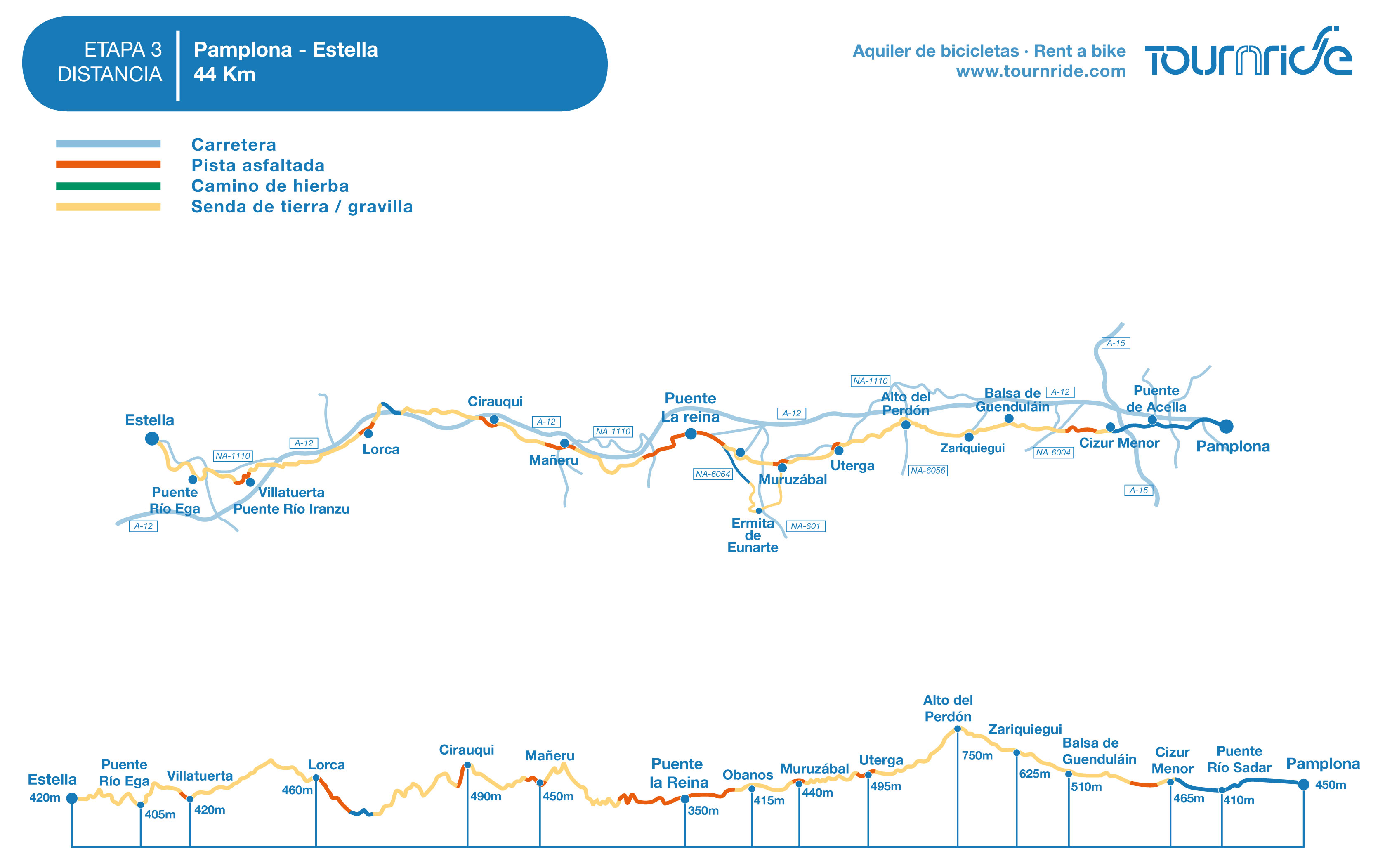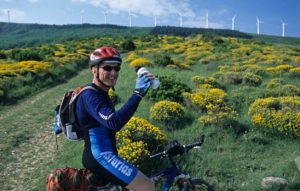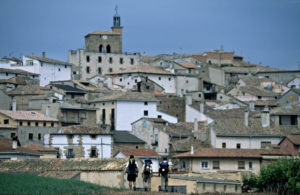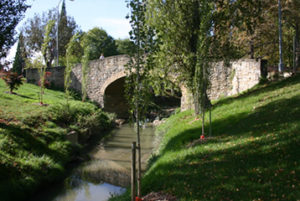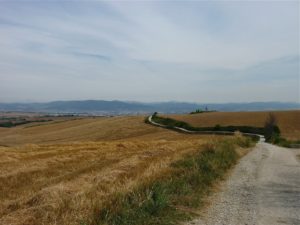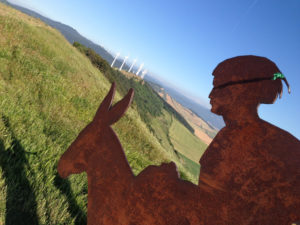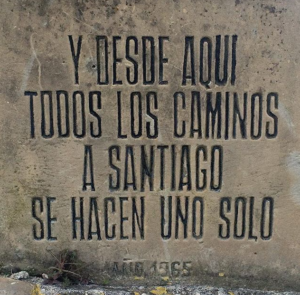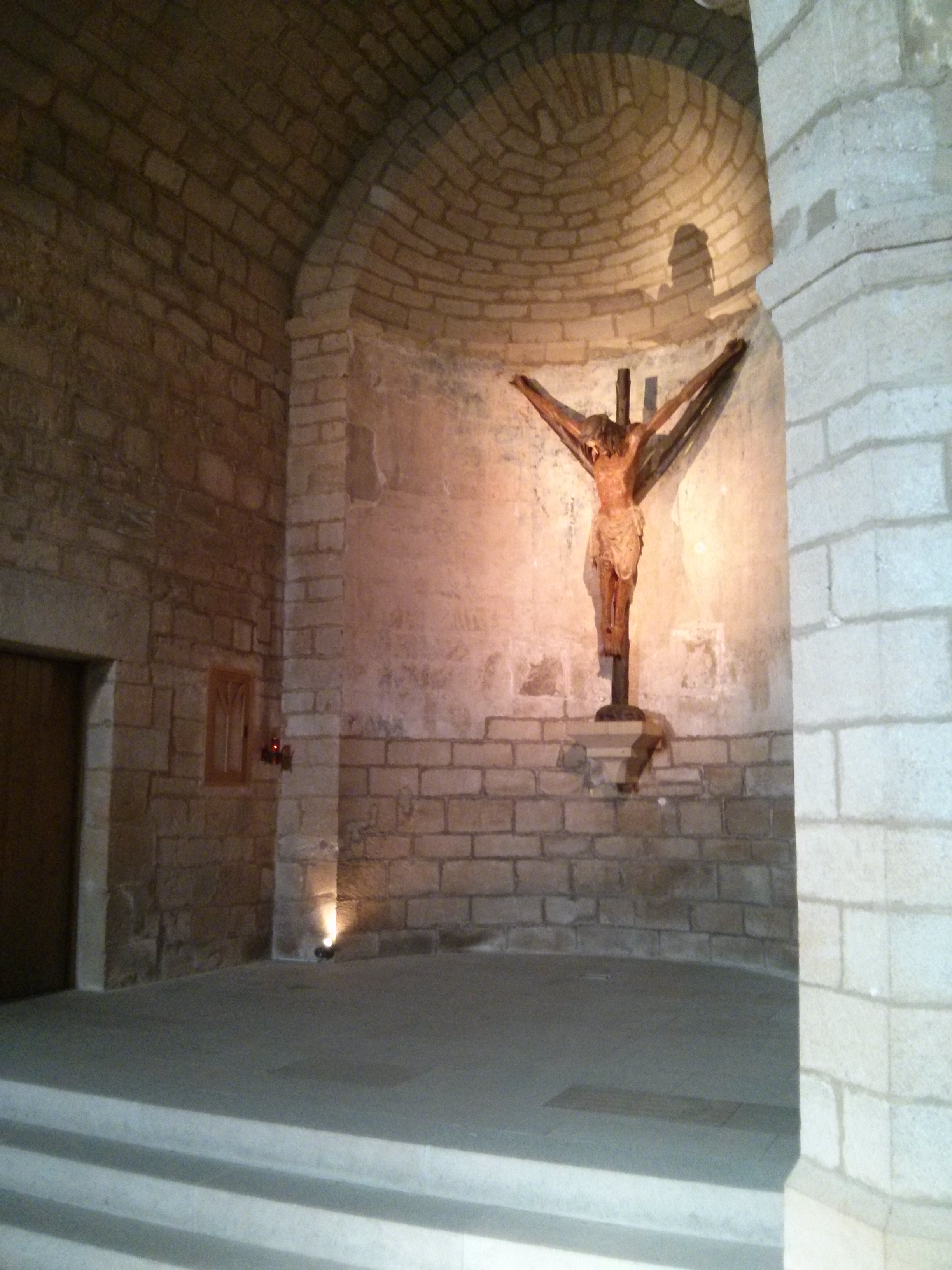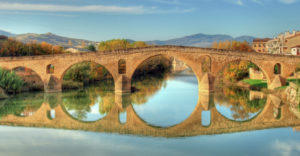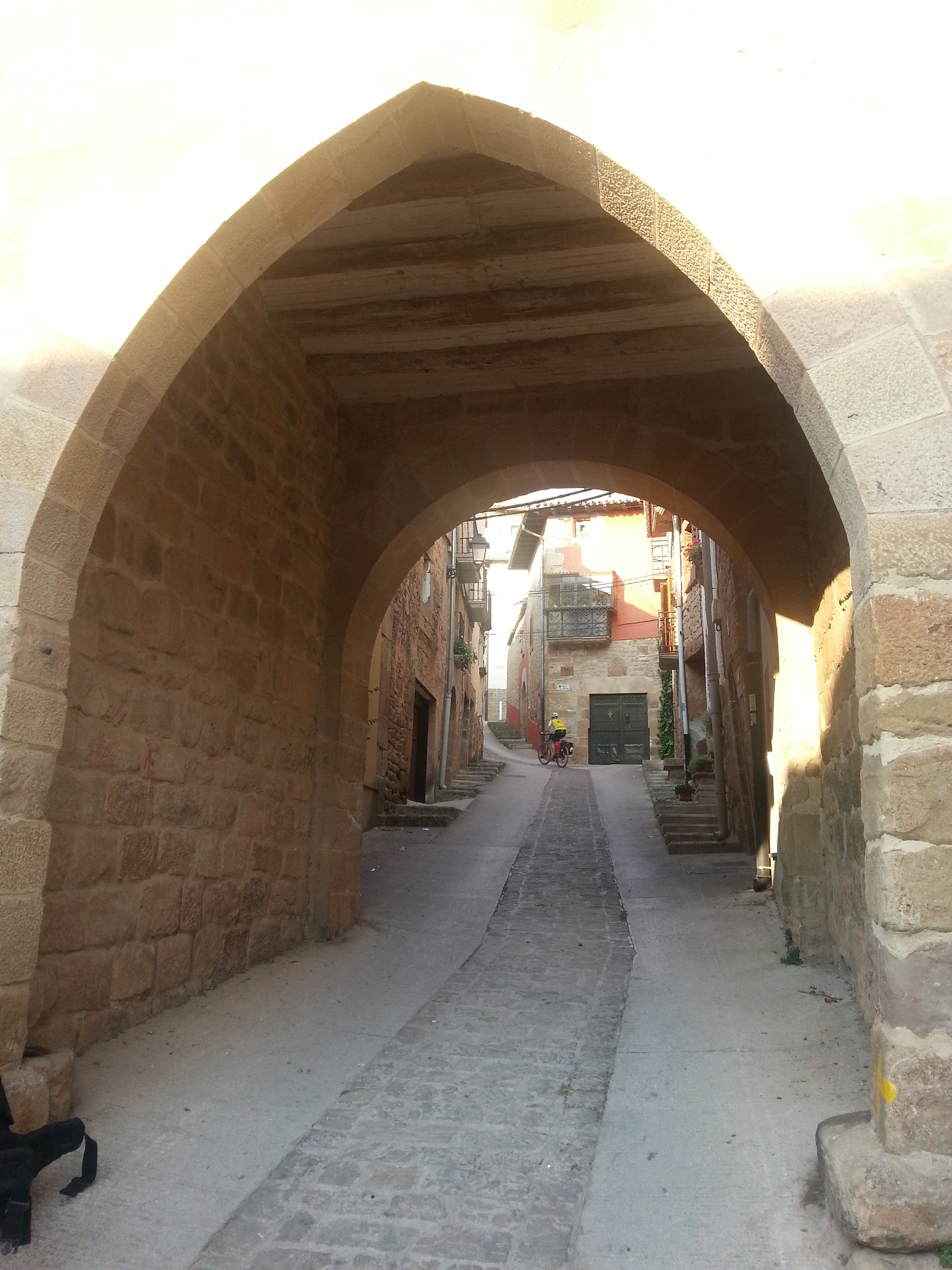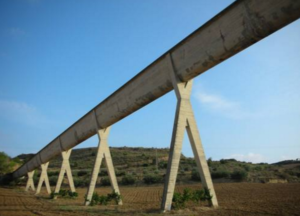STAGE 3: FROM PAMPLONA TO ESTELLA
Xavier Rodríguez PrietoFRENCH ROUTE BY BIKE
- Distance to Santiago: 705 km
- Stage distance: 44 km
- Estimated time: 4 hours – 4 and a half hour
- Minimal height: 397 m
- Maximum quota: 780 m
- Difficulty of the route: mid
- Places of interest: Alto del Perdón, Church of Santa María de Eunate, Puente la Reina, Cirauqui, Estella.
- Itinerary in Google Maps: To see the tour in Google Maps click here
This stage of 44 km is characterized by a continuous ascent from Pamplona during the first 12 km until reaching the Alto del Perdón (780 m), maximum route quota. From there we will descend for about 4 km on a steep slope until we reach Uterga. We recommend caution to avoid injuries. But, as always, “after the storm, calm always comes.” Therefore, a much smoother terrain profile will lead us to our end of stage: Estella.
In addition, today the pilgrims, who started in Somport and have toured the so-called Aragonese Road, will be joining us. Near Puente la Reina, in the middle of the stage, we will meet them and will be together until arriving at Santiago de Compostela.
Along the road, today we can see a curious monument to the pilgrims in Alto del Perdón. We will also pass by one of the most emblematic localities of the Camino Francés: Puente la Reina, urban prototype of population born around the pilgrimage route. Near Muruzábal we can turn aside to visit the church of Santa Maria de Eunate, one of the most magical temples of the road.
Medieval and picturesque villages will splatter our route, which we travel through agricultural paths or ancient Roman roads between large tracts of cereal fields and vineyards.
Welcome to the Navarran countryside, a haven of peace!
GENERAL PROFILE STAGE AND ROUTE
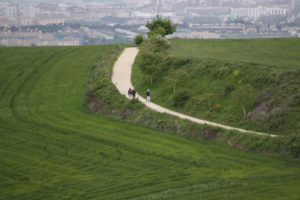
As we have already noted, the profile of this stage is much less brittle, but requires an initial effort to climb to the Alto del Perdón, where we can see the road from Pamplona at our left, and on our right, the valley that we still have to go. From Puente la Reina there is only one ramp that will really make us sweat. It is 1.5 km and takes us from the edge of the Arga leaving from Puente la Reina until Mañeru. The rest of the road to Estella runs along paths between cereal fields and vineyards, crossing several times with the A-12 in underground steps.
Leaving Pamplona by the university we will take a quiet road that crosses a fluvial park and, in a slight ramp, we arrive to Cizur Menor. We left the residential nucleus and started to climb towards Alto del Perdón by a first dirt track and a grass road later, with an average slope of 2%. At the end of the grass road, a little before the eighth kilometer of our stage, left to the left Guenduláin, now uninhabited.
Here the slope will become higher and higher From Guenduláin to Zariquiegui the average climb inclination will be about 5%. Arriving at Zariquiegui we will be at the foot of the Monte del Perdón peak (1034 m) and we will see in front of us the ramp that will take us to the high that we will reach in this route, with a quota of 780 m.
To reach the Alto del Perdón from Zariquiegui we saved a difference in altitude of 125 m in less than 2.5 km, following a ramp that can reach 15% incline several times. This rise can sometimes be made harder if there is a lot of wind, a circumstance that is not unusual. In fact, the sound of windmills moving with the air will be with us through the road.
When arriving at Alto del Perdón we can stop to rest, admiring the views. To our right, we will see the valley that we will cross to Estella, a whole picture of cereal fields dotted with small towns.
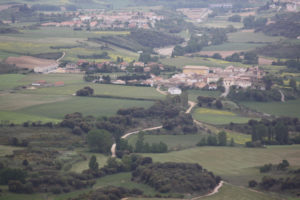
With the descent from Alto del Perdón you have to be very careful, especially if it rains. It is difficult because it can have a slope of up to 12.5% (although the average will be 7%) and the ground is unstable. There are enough loose stones and it can wind up, which does not help the balance. If you do not have much experience in complicated slopes and you see that the wheel begins to slide, do not hesitate to get off and take the bike to your side helping you with the brakes. The descent is about 3.5 km so you will not lose much time. If you want to abolish this whole stretch, take before the Alto del Perdon the N-111 and border the mountain.
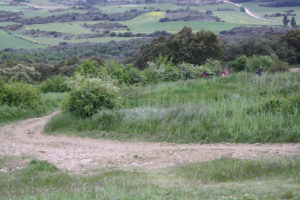
The descent takes us straight to Uterga. After crossing the village we go to Muruzábal, where we will arrive after the 18 km route. There you have to take a dirt track that runs to the right from the village. Just 2 km after walking that flat path, we will arrive at Obanos.
Kind of between Muruzábal and Obanos there is a stop that we cannot miss: the church of Santa Maria de Eunate. It is a very unique Romanesque temple in an uninhabited place, for which it is well worth adding a few kilometers to the stage. To get to it we have to detour in Muruzábal, taking a different road from the center of the village and traveling for 2 km. It is not very well marked, so it is recommended to ask the villagers. They will be more than accustomed to seeing doubting pilgrims!
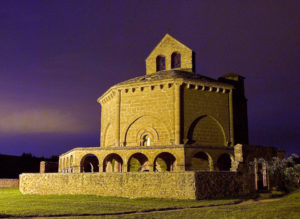
After about two kilometers we arrive to the church. Near this point we will see how the pilgrims who have traveled the Aragonese Way, which begins in Somport, also arrive.
From the church we must take the path towards the west, to reach Obanos, where we will retrace the path with those who have gone directly from Muruzábal without visiting the church of Santa Maria de Eunate. To get out of Obanos you have to go through a stone arch, and there is little to get to Puente la Reina, by a dirt track with a slight slope. It is a very pleasant walk.
We arrive to the Ecuador of our route in Puente la Reina (22 km), , one of the most emblematic localities of the road. We cross it and we leave town by its famous medieval bridge, passing on the same river that we crossed at the beginning of the stage: the Arga River.
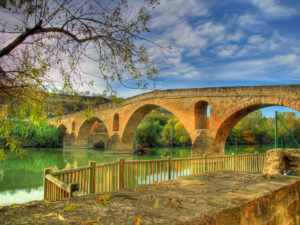
From Puente la Reina to Estella, the profile is so much flatter. We will only find two moments of quite a ramp: when leaving Puente la Reina to go to Mañeru and when we cross the town of Cirauqui, of steep medieval streets.
After leaving Puente la Reina we climb the ramp of 1.5 km between pine trees through a dirt track and we arrive to Mañeru. We cross the village and from there, we see a path of about 2.5 km in almost flat profile to Cirauqui. This path is very beautiful, runs between agricultural fields in a very quiet environment.
Arriving at Cirauqui we will have already passed 29 km traveling through this stage. This population of medieval origin has very steep streets. After crossing it, going up to the town hall and then going back down, we must walk 5.5 km until we reach Lorca.
The Cirauqui-Lorca route is very quiet: a profile with gentle inclinations by dirt tracks and asphalt crossing the A-12 through different steps.Already in Lorca we are only 8.7 km to reach Estella.
The landscape will remain similar, with large cereal plantations and vineyards delimited by agricultural tracks and national highways. We must first pass through Villatuerta, 4.5 km from Lorca. We can go by road (NA 1110, before part of the N-111) or take it to leave Lorca, and then follow a dirt path that leads us to cross a bridge and an underground passage to end at Villatuerta.
From Villatuerta we face the last 4 km, which we will walk on a slight slope, so it will be a pleasant stage end. With the same dynamic, we will follow agricultural tracks and we will have to pass through a last bridge and an underground passage. And at last, Estella.
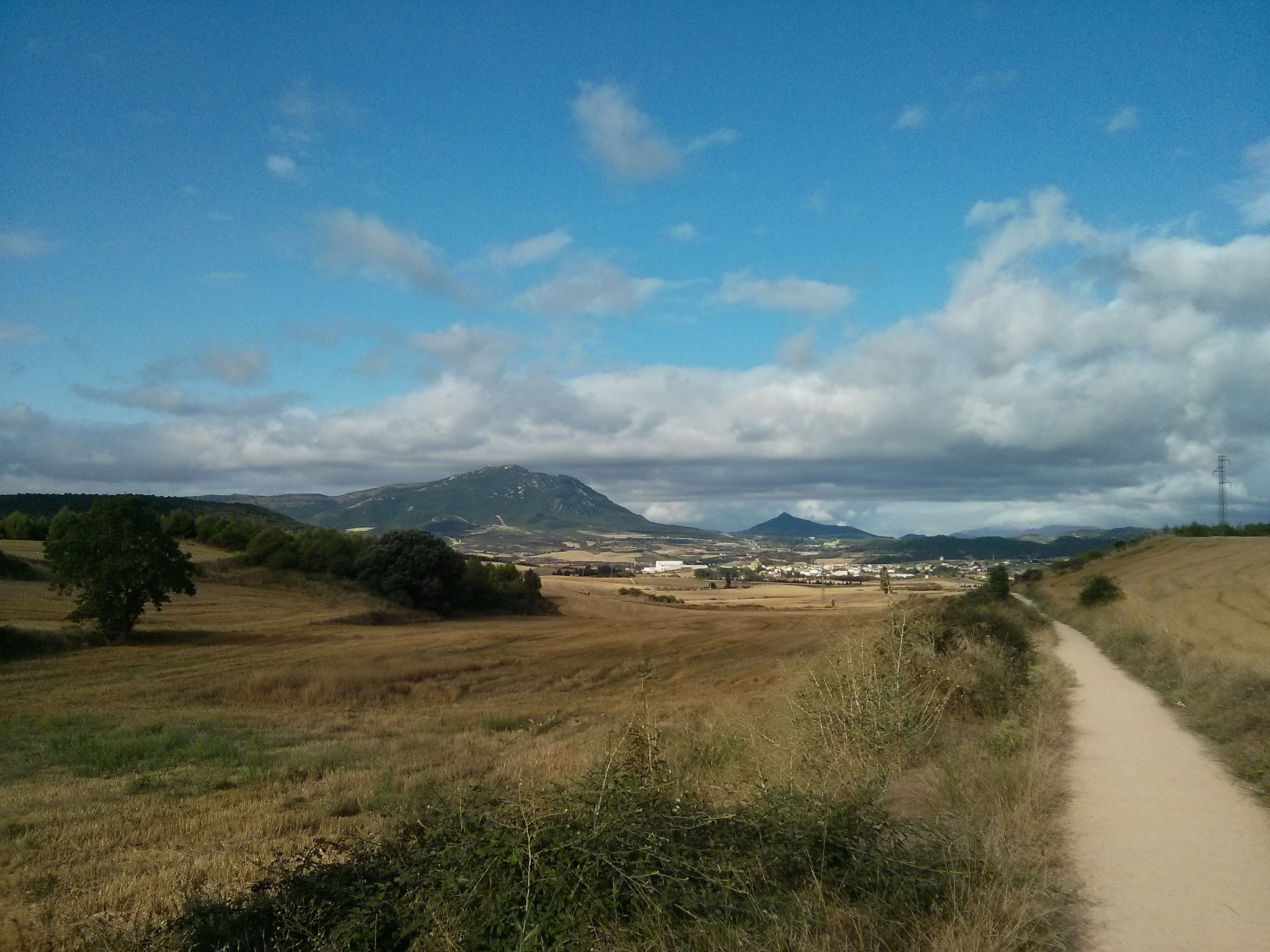
Resuming, although this stage can be done completely by local road, the original path is quite affordable and therefore Tournride recommends you to follow it. We only have to take precaution between kilometers 10 and 16 of our route, when the Alto del Perdón goes up and down. If you do not feel safe, you can skirt the mountain by road or get off the bike and push in some moments.
PRACTICAL TIPS
- Pamplona and Puente la Reina are places where many people start the journey. If this is your case, we give you options to get there:
- How to get Pamplona:
This modern city has a bus station, train stations and airport. Among all these safe transport modes you will find some that will bring you to the city.
2. How to get to Puente la Reina:
The best transportation option is the bus. The company that has most connections is La Estellesa with departures from Irún (2h 45min), Pamplona (30min), Logroño (1h 30min) and San Sebastián (1h15min). Conda and Avanza leave from Pamplona.
You can also go by taxi; there are special services for pilgrims. A 7-seater taxi from Pamplona costs around € 30.
** Remember that at Tournride we have luggage transfer service from start to finish on the way. Tell us where you begin to pedal and where you finish: we will leave the bicycle in your accommodation and take the excess luggage, which will wait for you in the place that you choose. If you have any questions you can consult our FAQ section or contact us.
- Many of the stage populations have shelters, in case you are tired and do not arrive until Estella. There are hostels in Muruzábal, Mañeru, Cirauqui and Lorca and, of course, in Puente la Reina.As in that locality joins our way with the Aragonese, there may be many pilgrims. Hikers have preference over cyclists in hostels. So, if you see that all are full but you want to stop, know that there is a camping-hostel past the bridge. You can also continue to Mañeru (5, 2 km), although you have to save a ramp of 1.5 km.
- As we propose Estella as an end of the stage, we redirect you here to get information about the 5 hostels that are in that population. You have at your disposal amunicipal hostel, a youth hostel (not only for pilgrims), two religious shelters (the Capuchin and the parish of San Miguel) and a , the Association of Navarre in favor of People with intellectual disabilities.
- In this stage we go through many towns and is a very traveled by pilgrims area, so it has many services. You will not have problems to obtain provisions and in the way you will be able to accede to enough doctors’ offices if it were necessary.
DETAILED ITINERARY AND HISTORICAL-ARTISTIC HERITAGE
Today we say goodbye to one of the great cities that we will cross in our cycling adventure, but we do it to discover wonderful things: medieval towns as emblematic as Puente la Reina, or the special Romanesque church of Santa Maria de Eunate. Our path will continue to be dotted with bridges from different eras and will run between large cereal fields and vineyards.
FROM PAMPLONA TO ZARIQUIEGUI: WE GET THROUGH THE NAVARRO FIELD
To leave Pamplona we must cross the university campus of the city. We leave by the Calle Mayor that takes us to the Park of the Taconera, the miniature zoo of the “pamplonicos”.We leave it to our right and we continue by the Pío XII Avenue until the Sancho el Fuerte Avenue, where we turn left and then in the first one to the right, by the street Fuente de Hierro. Going down this street we go now to the university campus of Pamplona.
We continue straight and go down University Street, along the campus bike path. When we reach the roundabout where the cars cross the Arga River, we follow the bike path that diverts right at the first exit of the roundabout. We cross the zebra crossing a little further and, now, we pass over the Arga River.
To cross the Arga River we pass on the stone bridge of Acella Landa. This bridge, three meters wide, has a single arch of about eight meters height. It is part of the Pamplona river park.
When crossing it, we enter directly in the municipality of Cizur Menor.After following the road for less than 2 km, passing over the motorway, we reach the population nucleus. Due to its proximity to Pamplona, this town is very urbanized and serves as a residential area adjacent to the city. In spite of this also it has heritage of great antiquity, like the Romanesque church of San Miguel Arcángel.
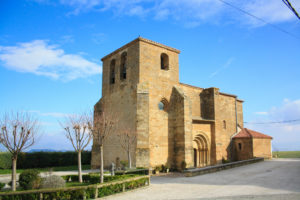
We cross from northeast to southwest, by a large urbanization. Afterwards, yellow arrows painted on pivots and a milestone with the shell on Zelaia Street indicates the path of the French Way.
We continue along the road, seeing to our left large extensions of cereal fields and, to our right, the urbanized area of Cizur Mayor.Almost 5 km of ramp that is hardening progressively takes us between agricultural fields and makes us leave behind Guenduláin to arrive at Zariquiegui.
When entering Zariquiegui, we find in our left the church of San Andrés. Of Romanesque style, it emphasizes its great cover with several archivolts and the vegetal decoration of its capitals. In the tympanum, as we saw in the church of Santiago de Roncesvalles, there is a carving of a crismón. Like there, it is a pictogram that representing Christ as the beginning and end of all things, through the first and last letter of the Greek alphabet.
WITH THE WIND PUSHING UP TO THE HIGH OF FORGIVENESS, EMBLEMATIC PLACE OF THE FRENCH ROAD
The sturdiness of this temple, which has been welcoming pilgrims since the 13th century, gives us the strength to face the ascent to the Alto del Perdón. It is a ramp of little more than 2 km that is not especially fatiguing, but it can harden if it is very windy and, as already said, it is not unusual that that happens.
In fact, on reaching the summit of Alto del Perdón (780 m) we will see how one of the figures of the sculpture that is there can be read: “where the road of the wind crosses with that of the stars”. This sculpture was designed by the artist Vicente Galbete in 1996. The fact that it refers to the Camino de Santiago as the “one of the stars”, it’s related to the legend of the discovery of the remains of the apostle. It is said that the hermit who discovered them, did so because he saw stars raining over a valley. Hence the name of the city and the road: Santiago de Compostela would be Santiago of the campus stellae. Meaning stars field.
In this case, the allusion to the “path of the stars” also refers to what the sculpture itself represents. Formed by different forms of plaque, you can see a group of pilgrims from different times heading towards Santiago guided by the Milky Way.
In Alto del Perdón we can also see a marker with distances to different world capitals and a wall with an empty niche. The remains of stone remind us that formerly there was a complex formed by a hermitage and a hospital of pilgrims, abdicated to the Virgin of Forgiveness. The sculpture of the Virgin today is found in Astrain church. It was carried there in the 19th century, when Napoleon’s army desecrated the hermitage during the Independence War.
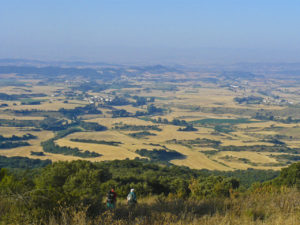
But the thing that makes the Alto del Perdón really special is the views it offers from the Navarrese landscape. Behind us lies the basin of Pamplona and, ahead, we see Valdizarbe Valley and its hills, behind which is the Puente la Reina.
This is one of the most emblematic points of the French Way. Its name remembers the integral forgiveness of sins obtained by the pilgrimage, which has been an incentive for the realization of the Way from the Middle Ages. Surely also in reference to this sense of the fight against the sins arose a legend that is situated in this place.
It is said that the devil tried to buy the will of a thirsty pilgrim by offering water from a source of this mountain range. He asked that, in return for water, renounce God, the Virgin and Santiago. But the walker did not fall into the trap, and finally the apostle himself appeared miraculously to cast Satan.
GOING DOWN WITH CARE TO VALDIZARBE VALLEY. FIRST STOPS: UTERGA AND MURUZABAL
If we continue along the path from Alto del Perdón, we will descend from the sierra by a steep slope. It’s a tricky descent. Alternative: go by road, not a big detour.
To go by road we take the NA 6056 that passes through Alto del Perdón and we make the final curve to join the NA 1110. In less than two kilometers we turn left to link with the NA 6016 that leads directly to Uterga.
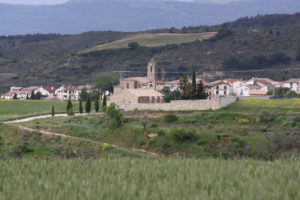
Views of Uterga from the driveway (photo provided on Flickr by Hans-Jakob Weinz under the following conditions)
However, all the roads lead us to Uterga! We enter the Asuncion street, where is the church that bears the same name.Its solidity resembles that of Zariquiegui, but this temple is later, from the 16th century. The tower and the portico, the two elements that most characterize it, are of the XVII and XIX respectively. The portico is reddish brick and in front of it there is a precious olive tree and benches to sit on. Another good place to do a little break.
We leave the village by the street of the Eras and in less than 2.5 km by an agricultural path in profile on a slight slope we descend to Muruzábal. From this point we are going to see how the cereal fields leave space also to the vineyards.
In tune with the introduction of the vineyard in the landscape, we find in Muruzábal a winery that can be visited. It is located in the Muruzábal Palace, a large baroque building that was erected as a residence of an important Navarrese family. Nowadays it is bottled in its own wine and, together with the church of San Esteban, is one of the great attractions of the town.
LET’S TAKE A DEVIATION…. EVERYTHING FOR THE PEACE THAT TRANSMITS SANTA MARÍA DE EUNATE
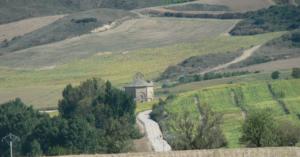
Whether or not you are great lovers of Romanesque art, from Tournride we recommend you visit the church of Santa Maria de Eunate. It is one of those magical places of the French Way, a special and wonderful construction in the middle of acres of agricultural field.
In fact, the detour does not increase the distance so much. If you go direct from Muruzábal to Obanos, you will cross a path of 2 km. If, instead, you leave Muruzábal in a southeasterly direction to get to the church and then you go to Obanos, you only add a kilometer to your route. Worth it!
There are many beliefs and legends that surround this temple in such a characteristic way. Santa Maria de Eunate is special, above all, for three reasons:
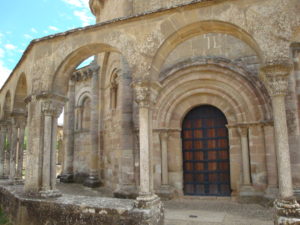
- Its location. Plus being even today “in the middle of nowhere”, it is located exactly in what, according to our current political map, is the center of Navarra. They say the experts in the subject that is erected in a place in which different flows of energies come together.
- The lack of documentation about the church. Although the majority of experts date it in the S. XII and that forms part of the Way of Santiago, almost is not mentioned in almost any historical text. Strange, do not you think?
- Its way. The church is Romanesque and octagonal, which by itself is rare. But, besides, it is not a perfect octagon and it is known that given the constructive quality of the building they could have done it well if they had wanted to. In addition, a portico exempt of 33 arcs repeats that same form around it, and there was never a cover that unites it to the building, since there are no marks of fastenings in the stone. Why then build those arches? Why not give a perfect shape to the temple?
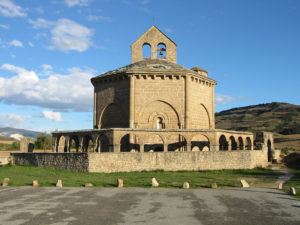
Many questions and few answers. Since the church resembles in its form the Holy Sepulcher, it was said that it could have relation with the Templars Order. But historically speaking, this does not make much sense. What is believed is that it could be of the Order of the Knights of San Juan, who attended and protected the pilgrims. This is thought because it is known that this area had influence and have been found remains of ancient burials with scallop shells around the church. That is why one hypothesis is that in this place this order had a hospital for pilgrims.
If so, it could also be that the central tower of the church serves as a lighthouse. By lighting a fire in it would be seen from afar and so the pilgrims would not be lost on the road.
AFTER A MAGIC STOP, WE REMEMBER JACOBEAN LEGENDS IN OBANOS AND GO TO PUENTE LA REINA
From the church of Santa Maria, we take a path of earth in a westerly direction that in few meters ends in the road that takes to Puente la Reina. But, before arriving, we will leave Obanos to our right.
For those who decide not to go to see the church of Eunate and therefore pass through this town or, also, for the curious who decide to stop there to meet her, we leave here a little information about this place.
Obanos is a town with a great Jacobean tradition. In fact, the most important party of the town is every two years and consists of a theatrical performance in which more than 600 people participate and in which a legend of the Camino de Santiago is staged. According to the so-called “Misterio de Obanos”, a duke pilgrimed with his wife when they passed through the town and she decided to stay there to help in the hospital of pilgrims. Her husband was so angry for his decision that he ended up killing her and crying about it for the rest of his life. Later, he returned to the village and retired until he died in the hermitage of Arnotegui, which still exists today and is in the vicinity of the village.
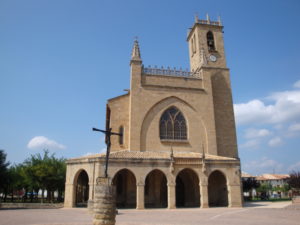
Architecturally, Obanos is characterized by its cobbled streets and the beauty of some of its houses and civil buildings, with large arches of stone.. The best known are Casa Muzqui, Tximonco or Cildoz.
the two variants of the French road (the one that begins in Somport and the one of Roncesvalles) converge. Sometimes it is said that the two roads meet in Puente la Reina, as many pilgrims pass through Obanos bordering it and therefore join with the rest in the next stop.
The church of San Juan Bautista is of 1912, of neo-gothic style. Their asymmetry is because they reused some of the parts of the previous Gothic church, so it only has a tower. The cover is also from S. XIV. Inside, a large nave covered with white tiles welcomes visitors, with an altarpiece in the apse, S. XVII.
When leaving the town, we won’t be lost thanks to the low originality of the street names: both taking the street Pilgrims of Compostela and the Way of Santiago will end at NA-6064, which after turning to the left to take the NA -1110 will take us direct to Puente la Reina.
ROUTE ECUADOR… THE EMBLEMATIC PUENTE LA REINA!
At the entrance of Puente la Reina we receive a monument to the pilgrim way.. Since 1965 welcomes all visitors on a basis in which you can read: ““And from here all the roads to Santiago become one””. Although we already know that, being strict, it is not where they converge but in our already visited population of Obanos.
We have already passed through other towns with much of their history linked to the Camino de Santiago. But, never better, we can say that this is the “queen” of all: born by and for the pilgrims. Other towns that we passed risen due to its proximity to a hospital of pilgrims or a monastery, but Puente la Reina is a town whose main vertebrae is its own road and that, in addition, preserves that original urban plot of “town-street”.
Therefore, it reflects in its urban design its own history. Its main streets are parallel to the Calle Mayor, the road to Santiago. In the middle of this is the Playa Mayor. And the streets which are today the “new enclosure” and “old enclosure” that close the old area, which formerly were the wall itself. Everything closes in, creating an almost perfect rectangle.
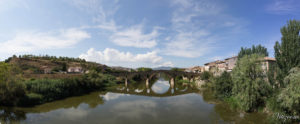
In fact, its original inhabitants were the “francs”, those foreigners who entered through France on the peninsula of which we have already spoken previously. King Alfonso I gave them a “carta puebla” to promote the founding of the city, that is, he gave them a series of trade deals and taxes in exchange for being settled in that place.
The reason for this is that in the 12th century the Arabs were losing territory, and one way of securing it was to create settlements in territories that were once again of the Crown. where Puente la Reina is today, a few years before Queen Doña Magna had built a large stone bridge so that the pilgrims could save the Arga River. On the edges of the Camino, next to that bridge and in the quiet valley of Valdizarbe; King Alfonso I found a good place for a new settlement.
The town was created having as axis the Road and during the following two centuries the pilgrimage to Santiago was a great medieval “phenomenon of masses” and this locality grew around that main street: churches, hospitals of pilgrims and trades for the walkers. Even the monk Aymeric Picaud, the creator of the first “guide” of the western world, mentions the place in the Codex Calixtino as a point of convergence of the Aragonese Way with the three that came through Saint Jean Pied de Port.
Today, all this overlap of stone history is in an exceptional state of preservation for the pilgrims who, almost a thousand years later, continue to visit it..
Just after entering the town, following the Jacobean sign that from the road points to the left, we find a stony memory of the antiquity of the place: the Romanesque church of the Crucifix. From the end of the 12th century, it was born as part of the complex of the old hospital of pilgrims (now a school) and owes its name to the old Cofradía del Crucifijo which from the S. XV managed the hospital.
In addition, inside the church, there is a large Gothic crucifix from the beginning of the fourteenth century, which marvels at both its size and its originality. Instead of having a “T” shape, Christ stands on a large “Y” carved so that the cross seems to be formed by large, natural trunks. The sculpture of Jesus gives a good account of the changes experienced from the Romanesque to the Gothic: it is a realistic and naturalistic Christ, who gives an impression of pregnancy and covered by large cloths that give a lot of dynamism. In spite of its large size there is correction in proportion and, in addition, the fineness in the size of each trait transmits to us sensation of pain and sorrow. One of the great works of Gothic imagery.
There are different speculations about the origin of this crucified Christ. Some relate it to the Templar Order and others say it was a gift from some Germans who carried the size throughout their pilgrimage and who ended up giving it as a gift to the hospital of pilgrims.
The street of the Crucifix takes us direct to the Main Street. In it we will see a whole life revolve around the pilgrims, in the form of shops in low stone big houses, with balconies forged in iron and large arched doors. When you go there you will find three points worth visiting: the church of Santiago, the Playa Mayor and the church of San Pedro.
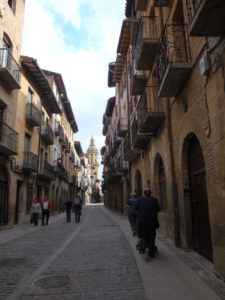
The church of Santiago was built almost contemporaneously with the one of the Crucifix, but today it is much larger due to the successive reforms it was undergoing. Also for this reason we can find a mixture of different styles in it: from Romanesque to Late Gothic and Renaissance.
Inside, the vaults of the main nave create complicated starry shapes with their nerves. They are held by huge Renaissance pillars. In addition, inside this temple we will be able to see one of the most famous carvings on the Camino, from which we already had an aperitif in the form of a copy in our visit to Roncesvalles: la escultura de Santiago “Beltza” o Santiago “Negro”. Although in all the French Way you can see more than 300 sizes of the apostle, this is one of the most known and admired. It is called the “black” (beltza in euskera) because before it was restored its complexion was that color.
Leaving the church, we continue along the main street and we arrive at the main square of the village. A good place to make a stop if we need it, sheltering us under its portico gallery. They adorn the place the beautiful buildings that give shape to it, especially the so-called “Flatware House”.
We continue along the Calle Mayor and, before leaving the village, we pass by the church of San Pedro. This one is way modern than the other two, of the S. XVI, although it has a chapel of gothic origin along with other three Baroque. The highlight of this temple is an altarpiece and a carving of the Virgin. The sculpture used to be a hollow of the medieval bridge that gives out to the town, and it is called the Virgin of the Txori (“little bird” in Euskera) because supposedly a small bird washed the face to him every day with water that caught of the river with its peak.
After leaving the Calle Mayor behind us we arrive at the great medieval bridge that bids us from Puente la Reina and gives the start signal to the second half of our stage.
This marvelous medieval construction was commissioned in the 11th century by Queen Doña Mayor, wife of the Navarra King. Although most scholars argue that the name of the town is due to this fact, there are others who believe that since the Arga River was called “rune” in Basque, could be derived from “pons rune” (bridge over the Arga).
The stone bridge has 5 large pillars with mole that hold 6 round arches. The central arch is larger and the eastern one is not visible today because it has been buried. Formerly the bridge had three towers and in one of them was where the hole was where the Virgin of the txori, was, who according to legend washed a little bird with water from its beak.
TO MAÑERU AND CIRAUQUI BY AGRICULTURAL TRAILS: “POSTAL PHOTOS” FOR OUR ROAD
We leave Puente la Reina crossing its medieval bridge and then turn left.We cross a zebra crossing that introduces us to the neighborhood of Zubiurrutia, the so-called “barrio de las monjas” (Nuns´s Neighborhood), because it has a convent of Augustinians since the 13th century. The Arga River follows us parallel to our leftand so we continue straight until passing the purifier. A large pine grove on steep terrain occupies the space between the river and the A-12 motorway, the Auto via del Camino.
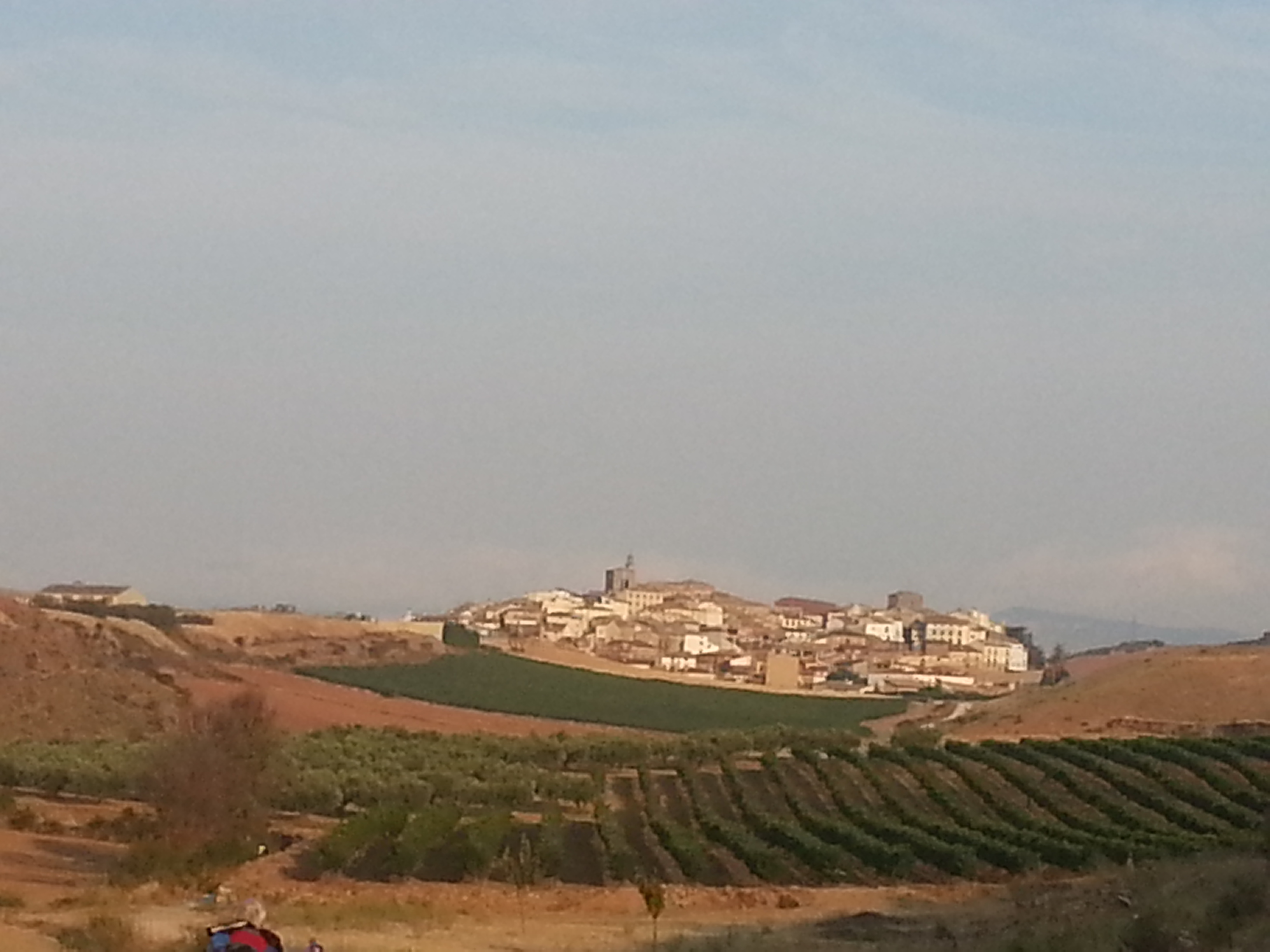
To get to Mañeru, which is next to the freeway, we will have to climb that ramp between pines. It is not a very long slope and it is also the last great effort of this stage but they are still more than 20 km ahead so, if you are tired; do not hesitate to raise it by pushing the bike.
We arrive to Mañeru, delimited by the A-12 by the north. We cross the village on its side and, leaving the villa, one of the most endearing views of the road we open before us. A whole path of land, between cereal fields and vineyards and, in the background, is Cirauqui.
Mañeru is a picturesque medieval village of less than 500 inhabitants.. Like our next stop, Cirauqui, it also retains its medieval layout set on a hill. This village has a great wine tradition, although nowadays the cultivation destined to vineyards has lost ground in favor of the cereal. Even so, a wine called “Belardi” is still produced and produced in a cooperative way.
During the middle Age the town was under the control of the San Juan Order, and soon happened to depend on Puente la Reina linked to the monastery of the Crucifix. It was also the scene of the first Carlist War. Today we can find in Mañeru all the services that we need.
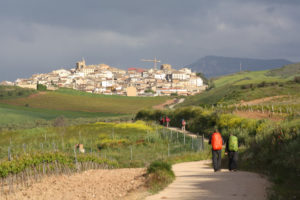
After crossing the town through its narrow streets and passing through the great square of the Fueros, we went through the cemetery area towards Cirauqui. To get there, we cross 2.5 km of agricultural path between large fields.
When arriving at Cirauqui we have to face the last great ramp of the day, since to cross the town means to cross its steep streets, entering by what is left of the old wall until reaching the city council. Before arriving to the town hall, from Tournride we recommend that you get off the bike for a few minutes to visit the Church of San Román.
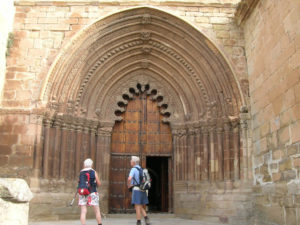
This church was built in the 12th century and belonged to the monastery of San Millán de la Cogolla (like the whole village). Although it has undergone many additions and reforms, it preserves its southern door intact. This cover is very interesting because it is a sample of the mixture of three different influences that could be found at the end of the XII century in the Iberian Peninsula: it has elements of the Romanesque sculpture, the way to make covers of the Cistercian order and, also, decorations reminiscent of the Arab world. All of it a conjunction of currents.
Also there is a possibility of itinerary signalized at the entrance of Cirauqui that borders the town instead of crossing it. Precisely, it is designed for cyclists who want to avoid the ramps of the locality.
FROM CIRAUQUI TO LORCA IT’S ALL ABOUT ENGINEERING: FROM ROMAN FOOTWEAR TO MEDIEVAL AND MODERN AQUEDUCT BRIDGES
The path we take when leaving Cirauqui is part of an ancient Roman road and takes us straight to a bridge of the S. XVIII, built on another previous that was also Roman. Rolling on this road so old we arrive in a few meters to an overpass on one of the most modern roadway of Navarra, the A-12 or “Del Camino”.
We crossed the pass and followed the road for almost three kilometers, always with the freeway to our left. Then we must cross the highway again through an underpass. We arrive at a roundabout where we turn right to take the NA-7171, which crosses the A-12 below. After pedaling for about 500 meters we will see a great structure that crosses the NA-7171 above us: it is the viaduct of Alloz.
El viaducto de Alloz fue diseñado por Eduardo Torroja en 1939. Alloz viaduct was designed by Eduardo Torroja in 1939. Surely many do not sound their name, but that of their granddaughter: Ana Torroja, the singer of the missing group Mecano. Even so, we must not forget this great Spanish engineer, considered one of the great masters and artists of the reinforced concrete of S. XX. Designed this great structure to carry the water from the reservoir of Mañeru and today it is still standing, fulfilling its function and has already become an incentive for the realization of the Way of Santiago by Navarra.
A few meters later after passing the viaduct, a dirt road leaves from the road. When we take it we will arrive direct to another work of engineering, this time instead medieval, which is the bridge that crosses the Salado River.
This bridge is supported above two arches and is mentioned in the Codex Calixtino. Monica Picaud warns all pilgrims in his book to be careful, because he says that here they used the bandits to assault the walkers. Standing on the bank of the river and sharpening their knives, they told the pilgrims to give their horses to drink from the water of the river, which, because of the saltiness it was, killed them. Afterwards, they slaughtered the horses and took away the belongings of their owners.
LAST 10 KM … LITTLE MISSING TO ACHIEVE ESTELLA! We pass through Lorca and Villatuerta
After crossing the bridge, we turn left and continue along a dirt track until we pass through a tunnel that crosses, again, the A-12. When leaving the underground passage we will see an asphalted track that will take us direct to Lorca (kilometer 36 of route), that we will cross from east to west by the Calle Mayor.
Like many of the towns in the area, this locality in which today less than 100 people live has its history closely linked to the Camino de Santiago. More than 900 years ago it had a hospital for pilgrims and today it has two private shelters.
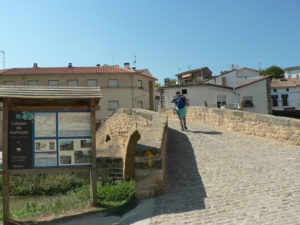
We leave the main street of Lorca to undertake the last 9.5 km of route to Estella. But first we must travel about 4.5 km to Villatuerta. We have two itinerary options:
- Go through the NA-1110 road.
- Take a dirt path that appears at our left when leaving Lorca and continue between paths of crops and vineyards. After crossing another underpass under the motorway, we will arrive at Villatuerta.
If you take the second option, you will see that there is a rest area just before passing the tunnel that crosses the freeway. There has been installed a monument in honor of a Canadian who died in 2002 when she was doing pilgrimage to Santiago.
WE ARRIVE TO VILLATUERTA AND WE UNDERSTAND THE LAST STEPS TO ESTELLA
Villatuerta is divided in two by the Irantzu River and to cross it we must follow the streets until arriving at a stone bridge of medieval origin. Like that of Puente la Reina, it is higher in the center than in the extremes. This is called “dromedary-type” bridges. Although, of course, this one is much smaller.
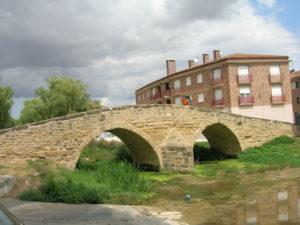
The other monument is the temple of the Asuncion. Formerly there was another tard-roman church in its place, but it caught fire in S. XIV and for that reason was constructed the gothic temple that we see today. It emphasizes, above all, its interior. It is very decorated, with even the remains of murals.
We leave the town by the northwest, by the “Camino de Estella”. We crossed a zebra crossing and came to a dirt path. When we see the road (NA 1110) we turn left to, for a short way, reach the hermitage of San Miguel.
This temple is almost obligatory visit for those who make the French Way. It rises like a fort, a huge stone mass surrounded by fields. It is the first pre-Romanesque temple that we will see in our route and, inside, many pilgrims leave papers with desires and rest for a while,, enjoying the peace that transmits the place and marveling with its splendid copper altarpiece with semi-precious stones. A medieval jewel.
In addition to being a traditional stop for pilgrims, the temple is also related to rites for fertility or to cure pains. Women who wanted to get pregnant would sit on a rock and hear mass. Also, in the central chapel there is a small hole and the people put in him the head to cure chronic pains.
We leave this church so special and we return to the road, and very little! To return to the route we have to step back a bit, taking back the short path that took us to the hermitage. Back on the road, we have to cross a last underground passage on the A-12 to reach Estella.
When passing, we continue and we see a bridge that crosses the Ega river and by the end, we enter following the street Curtidores we entered by the southeast to Estella.
A WALK BY ESTELLA
As always, in Tournride we propose you an afternoon walk, so that you know what to see and what to do in Estella, your end of the stage. You can see the itinerary of the walk here. They are just 35 minutes walking, and you can know many monuments of the town aquí. They are just 35 minutes walking, and you can know many monuments of the town!
First, a little history about what is known as “Toledo del Norte”
The fact that the Camino de Santiago passes through Estella is due to a decision of King Sancho Ramirez.. In the year 1090 decided that the route was diverted until the Ega river that crosses the population and gave a Jurisdiction to the francs so that they developed their activities there. With the great phenomenon in which the pilgrimage became in the following centuries, great constructions were developed in Estella.
The city development made different neighborhoods appear, being also very important the Jewish community of the place (until the Jews were expelled from Spain in 1492). In addition, it should be noted that the whole movement of the pilgrimage involved the expansion of artistic currents, which was reflected in the populations of el Camino. The monumental result of all this in Estella makes it often called “the North Toledo”.
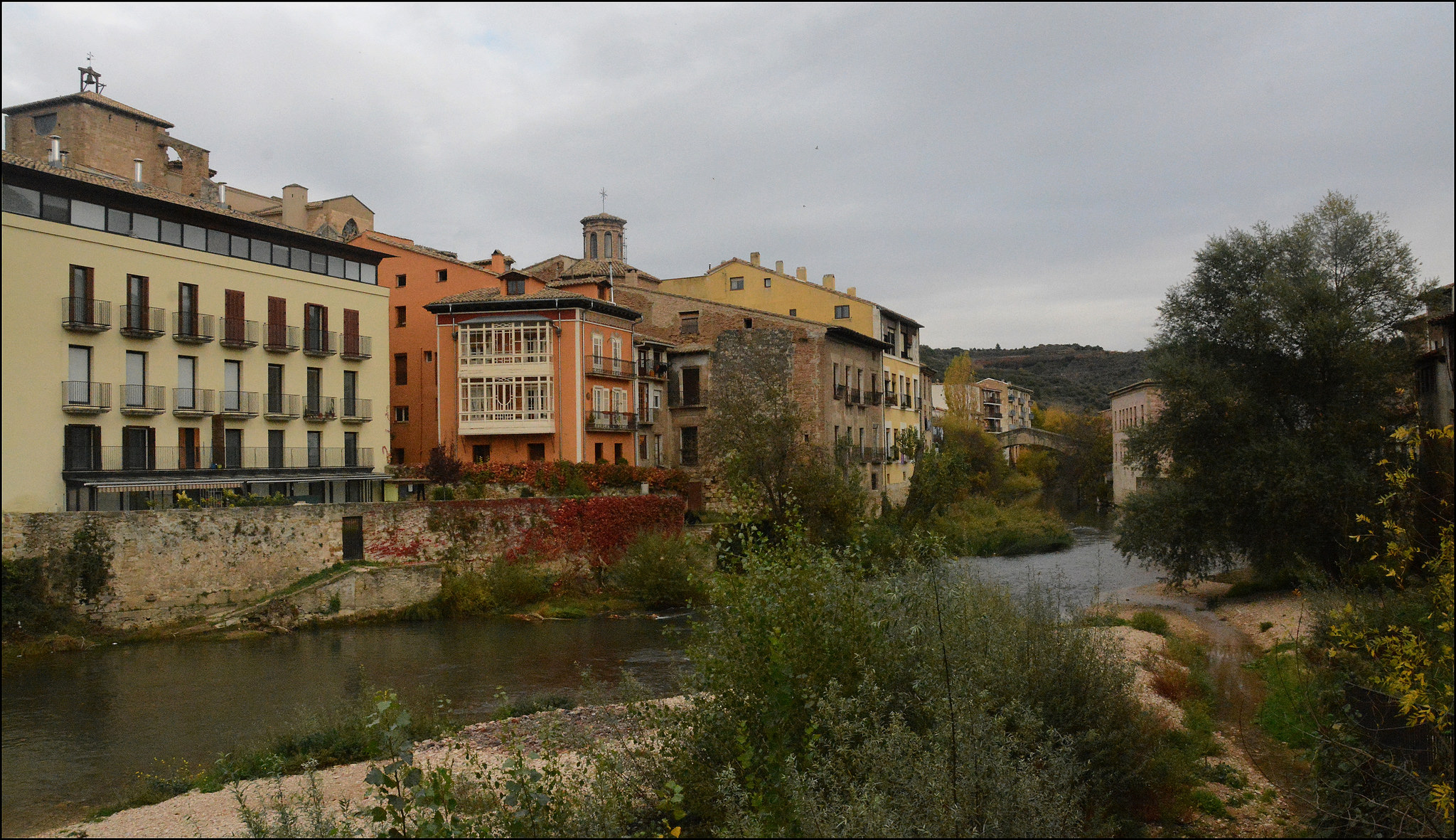
We go for a walk, too much to admire in just half an hour!
Upon entering Estella, either by the NA-1110 or by the original path, you will end up in the Curtidores Street. In it you will find a municipal hostel where you can rest, but if you are full you can always try to find a place in the other four hostels of the village (see more about accommodation on practical advice stage).
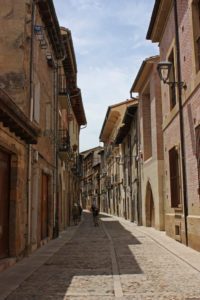
In the vicinity of the Curtidores Street, we find a point with several interesting monuments:the Santo Sepulcro church, the Santo Domingo convent, the Santa Maria Jus del Castillo church and, following the street by the river, The the Navarra Kings Palace.
The Holy Sepulcher church is the first thing we will see upon entering Estella. During the Middle Age it was the main temple of some of the neighborhoods or boroughs that constituted the locality. Today we can see the different influences that left a dent in his factory since the 12th century. Only one of the ships is from that century and most of what remains is from the S. XIV (Gothic). A particular note is the main front, with 12 archivolts forming a huge flare door. It has a lot of decoration, highlighting a Santiago figure dressed as a pilgrim.
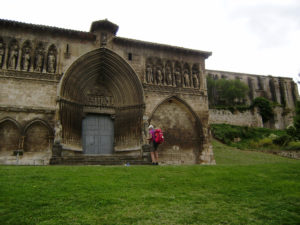
Side by side, are the Santo Domingo convent and the church of Santa Maria Jus Del Castillo.To go from one to another we will return to the Curtidores Street and see the Picudo bridge over the Ega river, another example of the “dromedary” type.
The Santo Domingo convent reflects the importance of the relationship between the Church and the Crown in the middle Ages. It was the king of Navarra who ordered and paid for the construction, but the Dominicans, who were going to occupy it, gave benefits to the faithful and helped to maintain it. Due to the cruelty of the Independence War before Napoleon, the monks flee the convent and although it is later inhabited intermittently, with the confiscation of 1939 is abandoned and remains in disuse, until at the middle of the century only remained the Walls. In the 60’s and 70’s it was rehabilitated and now functions as a nursing home, so it cannot be visited in the interior.
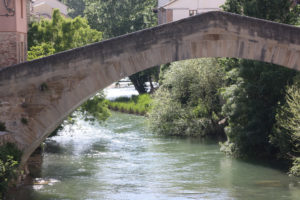
Almost adjacent to the present residence is the church of Santa Maria Jus del Castillo. Formerly, in the place where it is, there was a synagogue. In the 12th century, the site is occupied and this Christian temple is built, which maintains its function as a church until the XVII C. Although initially called the Holy Mary and All Saintschurch, with the construction of the castle of Zalatambor in a nearby high, you will begin to know as the church “under the castle” (“jus” del Castillo, in euskera).Then begins a process of deterioration that stops when at the end of S. XX it is decided to use this valuable space artistically and historically as a center of Interpretation of the Romanesque and Camino de Santiago.
If we return to Curtidores Street, we will arrive at the Museum of Carlism, which is right next to the pilgrims’ hostel we already mentioned. It occupies the space of the old palace of the Governor of Navarra, of the XVII Century. If you are interested in Contemporary History you will surely find here a place to enjoy learning, since in addition to promoting research on Carlism, the museum has a clear didactic and pedagogical approach.
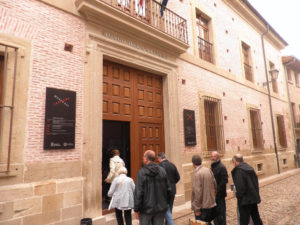
Carlism was a political movement that appeared in the nineteenth century in opposition to liberalism. While the new liberal political current wanted to remove the Bourbons from power and change the political and economic system, the Carlists were betting on a system more similar to the Old Regime in which the Church and the Crown had a lot of presence. Basically, its essence is summarized in the motto “God, Fatherland, King”. The curious thing about this movement is that it extended and evolved a lot over time, as it even persisted until the end of the Franco dictatorship. In addition, during the S. XIX the different attempts to seize the power of his followers led to three different civil wars.
Many of the areas that today are part of the Camino de Santiago in Navarra were scenario of battles during these three Carlist wars, which is why this space has been dedicated to the study and research of this political movement.
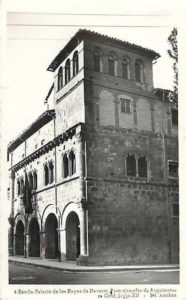
Coming back to Curtidores street, we continue walking it towards the west and we arrive at the San Martín Square. In it there is a beautiful 16th century Renaissance fountain with trees and benches where to rest admiring the two monuments that surround us: the palace of the Kings of Navarra, in the square itself and, on the other side, the San Pedro church.
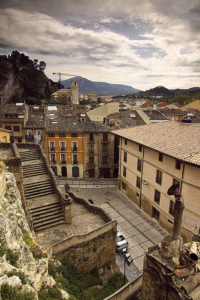
The palace of the Navarra Kings is very important because it is the only rest that remains in Navarra of Romanesque style civil architecture. As we have seen so far, most of what remains of this movement of the 11th and 13th centuries is reduced to religious buildings. But, in this case, we can see how it is applied in a civil construction, although the original function of the space is not clear. There are some scholars who believe that the Franks with power were there that governed the different boroughs of the old Estella. Others believe it could be a large cellar and barn with a room for the governor of the kingdom.
Regardless of its original function, the building stands out for its conservation. Its current facade is divided into three horizontal bodies with two towers. The medium body, with large windows, rests on a large porticoed gallery. The upper part is an extension of the XVII. Nowadays it houses the artist´s Gustavo de Maetzu museum.
In front of this square you will find, on a higher level (there are stairs and a lift to get there) the largest church in the town and one of the main attractions of the place: the San Pedro de la Rua church.
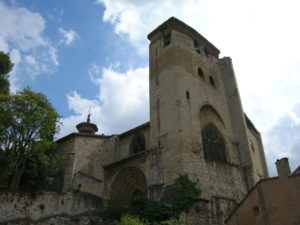
This temple occupied what was the center of the medieval city of Estella and it emphasizes especially with its cloister, very decorated. It was next to the old castle, from there its position in a high of the slope, of defensive end. In fact, the tower at the foot of the church gives the whole military aspect. Its oldest remains are of the XII Century and worked during the Average Age like pilgrims cemetery.
In addition to the remains of the cloister, stands out its entrance portico. As we have already seen in the church of San Roman de Cirauqui, the polylobulated forms of this one remind us of the influence of the Arab art that during XIII Century predominated in the south of the Iberian Peninsula.
The climb to the church is worth not only to see the whole in itself, but also by the views offered by Estella. We recommend you to stand on the stairs down to the square and enjoy a beautiful sunset with the Navarrese landscape in the background.
We restore forces with good gastronomy and places to rest
After so much racking of stage and tourism, we are sure that you want to rest and to eat something appetizing. Estella is a good place for it, not in vain Already in S. XII warned the monk Aymeric in his guide of the Way that was a place of “good bread, excellent wine, much meat and fish and all type of happiness”.
If you are of fish, you cannot leave without trying the ajorriero codfish, with vegetables and tomato. You can also find trout cooked in different ways. The carnivores will find in the roasts their great ally, especially of suckling pig (look for the “gorrín” in the letters of the restaurants) or of all type of hunting. In addition, like all the Community of Navarra, stands out for the good quality of its vegetables.
Sweet Tooths know that there are several shops with a lot of pastry tradition in the village. They are famous, above all, the puff pastry of Estella (“alpargatas”) and the chocolates bonbons.
If you prefer a more economical option, you can buy something to eat and enjoy it by picnicking in the Llanos Park, on the banks of the Ega River. There are also pools where you can take a bath and those who say that its waters are medicinal and have healing properties.
But do not forget to rest well after this day full of discoveries … Tomorrow we change community and do wine immersion in La Rioja!

